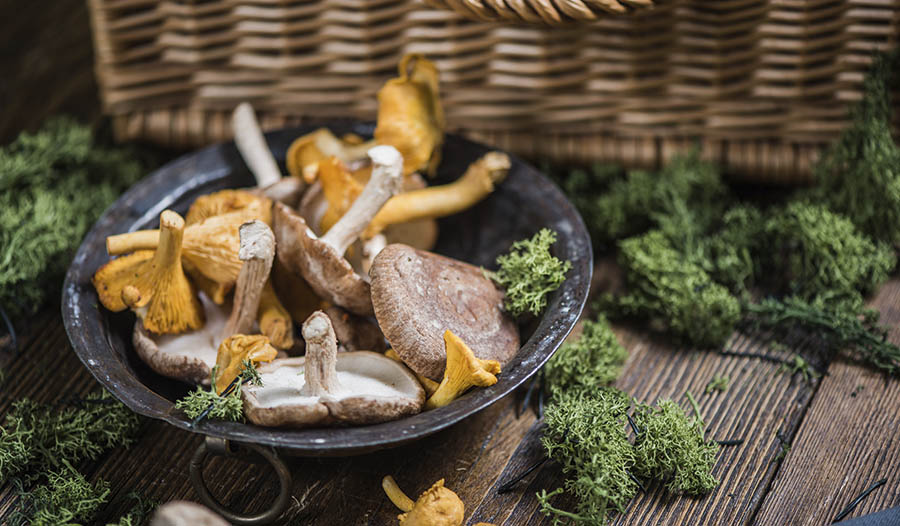Mushrooms for Immunity and Whole Body Health
DISCLAIMER:This blog does not intend to provide diagnosis...

Mushrooms are quickly becoming the new superfood. This is a bit ironic considering the relationship between humans and the fungi kingdom is as old as human existence itself. Modern trends are circling back to what our ancestors discovered long ago!
Mushrooms offer foundational support for our immune systems, containing compounds not found elsewhere in nature. Due to their powerful impact, many people are using mushrooms as the cornerstone of a complete immune support regimen to help stay healthy year-round.
Beyond immunity, modern studies are showing that mushroom mycelium and fruit bodies can support many other systems of our bodies. From energy to heart health to antioxidants to memory support, this huge range of benefits is putting mushrooms in the spotlight for supporting whole-body health.
Five mushrooms in particular – Reishi, Cordyceps, Lion’s Mane, Chaga, and Agaricus – can provide support for multiple functions within our body.
Reishi: “The Mushroom of Immortality”
With benefits for the cardiovascular system, energy support, endurance, cholesterol maintenance, immune support, and liver health, it is no wonder Reishi is called “The Mushroom of Immortality.”
Heavily researched, Reishi can support our hearts and arteries in a number of ways including reduction of cholesterol, triglycerides, and low-density lipoproteins. Reishi has also been shown to support energy production in heart cells.
Further research demonstrates a strong balancing of the immune system, especially when exposed to environmental triggers like animal dander or pollen. Reishi can help protect liver cells and support detoxification activity. Adrenal system support and increased endurance is yet another area that Reishi supports.
When considering the breadth and depth of research around Reishi, it’s clear why many turn to this magical mushroom to support overall health and longevity.
Cordyceps: Energy and Oxygen
Cordyceps is another mushroom that has worldwide recognition. Originally used for health in the Tibetan plateau, modern Cordyceps research confirms its ability to support lung functioning, energy, and libido.
Cordyceps can help the bronchial tubes and lungs relax and allow more air to pass into and out of the lungs. It also supports the amount of oxygen that can diffuse into the blood.
Further research addresses Cordyceps ability to increase muscle cell energy production and decrease lactic acid production. Together, this increases athletic performance but also efficient breathing.
Cordyceps may also impact libido for both men and women. Reinforcing intimate connection in our relationships requires energy, and Cordyceps supports that energy and drive.
Lion’s Mane: Mind and Memory
Lion’s Mane is quickly becoming a household name in mushroom supplements because of the research suggesting support for nerve and brain function. Lion’s Mane contains specialized compounds that trigger Nerve Growth Factors in our bodies. Our own Nerve Growth Factors then tell our stem cells to mature into nerve cells.
Lion’s Mane has also been shown to support cognitive functioning, memory and even mood. Lion’s Mane mycelium may support concentration as well. With all the positive support for the brain and nervous system, Lion’s Mane may be the world’s first ‘smart mushroom’.
Younger people tend to seek support with concentration, while older people become concerned with maintaining their cognitive function. Lion’s Mane can provide “thoughtful” support for us all, regardless of age. Need to find focus? Think about finding Lion’s Mane!
Chaga: Healthy Digestion, Lungs, and more
Chaga is a popular mushroom with some promising preliminary research as well. Chaga has powerful antioxidant activity, especially in specific cells called epithelial cells. Epithelial cells create barriers in our bodies. Our skin is made of epithelial cells, our intestinal tract and lungs are also made of epithelial cells. Chaga has a number of identified compounds that help balance the immune response associated with these tissues. Chaga can be helpful if your skin or intestinal tract or lungs are sensitive, especially to environmental triggers and foods.
Although much discussion has centered on the benefits of wild-harvested Chaga, some mushroom experts are increasingly concerned about ecosystem damage resulting from the large-scale wild harvesting needed to supply for the growing market demand. Fortunately, options exist for sustainably cultivated Chaga. And, interesting data suggests that sustainably cultivated Chaga may be more concentrated in some of the important health-supporting compounds, meaning you can benefit from Chaga in your diet while helping protect the wild population.
Agaricus Mushroom: Beyond the Button
With all mushrooms, it’s important to pay attention to how the ingredients are grown and harvested. When looking for Agaricus mushrooms, pay special attention to the species being used. For example, the Agaricus genus includes the common White Button mushroom, Portobello mushroom, and Crimini mushroom, which are all variations of the species Agaricus bisporus.
While Portobello and Crimini mushrooms are tasty and healthy when well cooked, most supplement shoppers will seek out immune support from well-researched species like Agaricus brasiliensis, also known by its former name Agaricus blazei. Research shows that the Brazilian “Blazei” mushroom offers a strong activation of specific immune cells.
All Together Now
An interesting aspect of both herbs and mushrooms is their potential to support multiple areas of health. A single herb or mushroom may have benefits across many systems. That said, strategic combinations of key ingredients can create synergistic benefits.
For example, a combination of Reishi, Cordyceps, and Chaga can support maximum lung functioning, cardiovascular health, and physical endurance. This would be a good combination for an athlete – or even a busy parent trying to keep up day to day!
For those seeking broad immune support as well as all the other benefits of mushrooms, “big” blends of 6, 7, or even a dozen or more mushrooms are incredibly popular.
Several brands are now offering combinations of mushrooms with more familiar, complementary herbs that all support the same health goals. If you love the herbs you already take but also want to try out the benefits of mushrooms, these cost-effective formulas could be right for you.
Keep it Clean
Transparency and purity are important to be mindful of. The mushroom organism spends much of its life underground or growing inside of organic matter (wood, grains, soil, etc) in its mycelial stage. During this time, the mushroom can accumulate compounds from whatever it is growing in. Plant parts like turmeric or ginger rhizome are no different in that respect.
However, rather than just absorbing water and nutrients like plants, mushroom mycelium is actually actively breaking up, digesting, and then absorbing what’s around it. Mushrooms and other fungi are nature’s powerful recycling service – so when shopping for mushroom products, it’s incredibly important to find reputable sources that grow in clean, safe conditions. Growers need to ensure high-quality, safe food for their mushrooms in order to produce the best mushroom ingredients.
Organic certification and independent testing for contaminants are always important indicators of quality.
Know Your Mushrooms
The mushroom life cycle consists of three stages: mycelium, fruit body, and spores. Mycelium is the main life stage of the mushroom, where most growth, gene expression, and development occur. While growing in the environment, mycelium must actively defend itself from many predators and competitors. Mushroom mycelium’s own defense mechanisms can benefit humans too!
When the mycelium is ready, fruit bodies can emerge, which eventually release spores. When supporting health, mycelium and fruit bodies are by far the most commonly used parts of the mushroom.
Mycelium ingredients should be grown on a food source that both mycelium and humans eat. Luckily, a food source such as organic brown rice is both effective and sustainable.
In addition to feeding the mushroom organism, the growth medium (ex: brown rice) becomes “cultured”, enzymatically changing the starches so that they become immunologically active. (Normally, organic brown rice has no detectable immunological activity.) This is much like how Lactobacillus “cultures” and transforms milk into yogurt, a product with new health benefits unique from the starting ingredients. The transformed growth medium becomes a reservoir for unique compounds from the mycelium.
For fruit body products, the growth medium is still important to consider. Some contaminants can become hyper-concentrated in fruit bodies grown on less-than-clean growth mediums. If fruit bodies are further concentrated into an extract, purity of the starting substrate is even more critical to ensure product safety.
Increased interest by the public and research institutions has helped the cultivation and technical understanding of mushrooms to grow exponentially over the past fifty years – and new discoveries seem to be always popping up on the horizon!
In supplements, mushrooms are best known for immune support, but we now know more about mycelium, fruit bodies, and their constituents. Today, mushroom products have been formulated to support healthy breathing, brainpower, detox/cleansing protocols, athletic prowess, whole-body support, or simple longevity. Get to know mushrooms and you will almost certainly find several you can use on your own journey of health.

 By Jerry Angelini, MS, LRC, LMT
By Jerry Angelini, MS, LRC, LMT 


